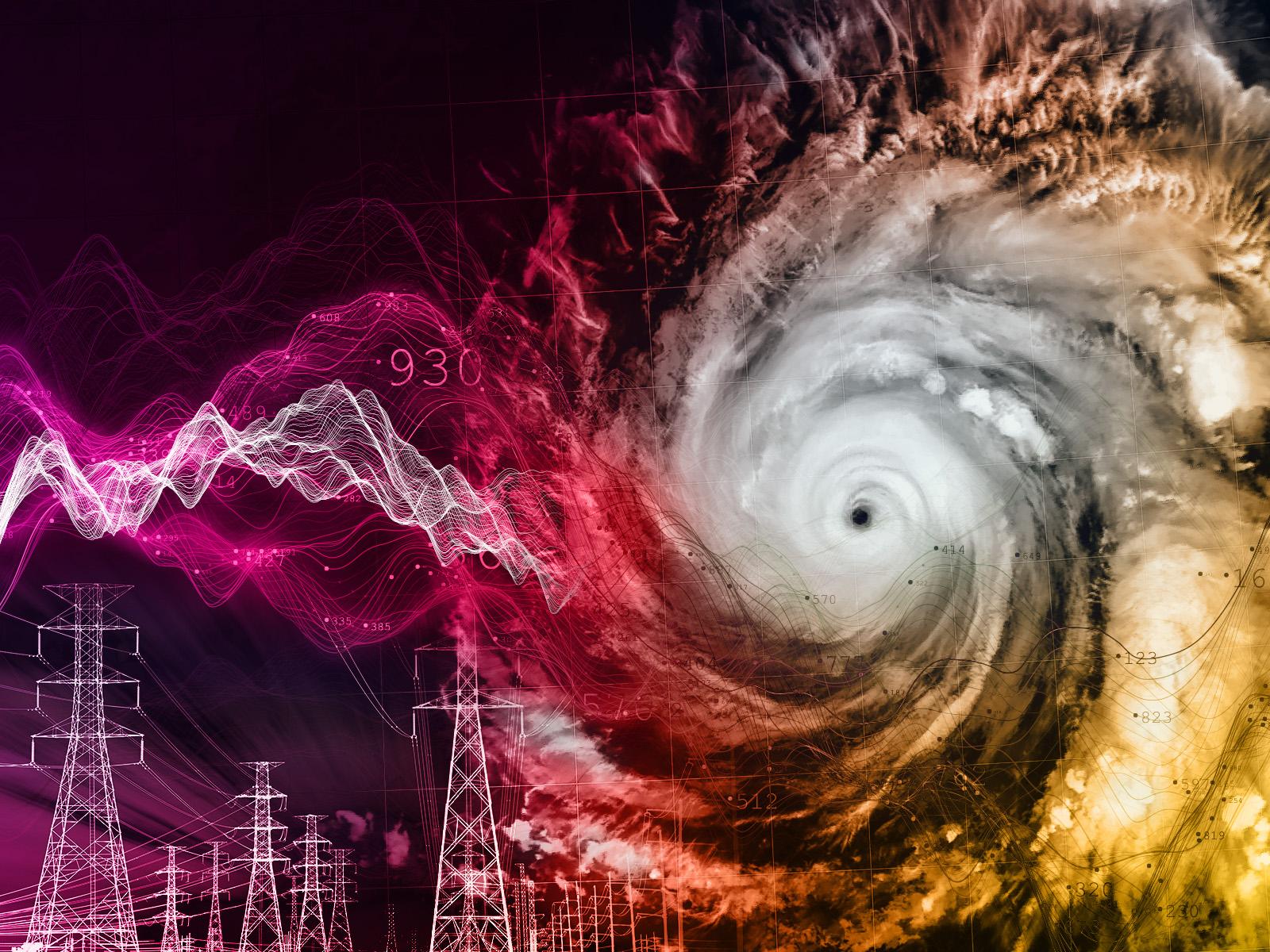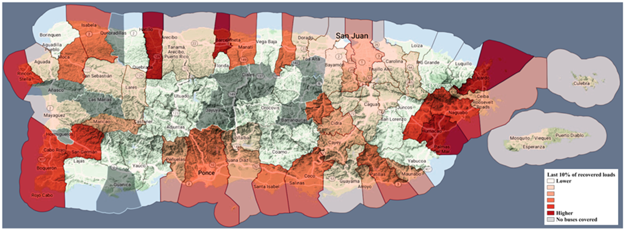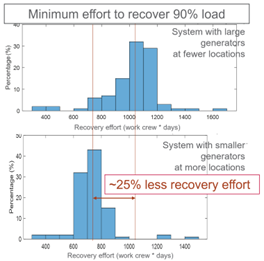Research Team Creates New Resilience Analysis Tool for Grid Recovery

In preliminary analysis, the Recovery Simulator and Analysis (RSA) tool ran simulations of 100 hurricane recoveries and found that smaller size and more distributed future generation could cut the transmission recovery effort—work crew days—by approximately 25 percent.
(Composite Image by Melanie Hess-Robinson | Pacific Northwest National Laboratory)
A new resilience analysis tool that simulates time and effort needed for the grid to recover from severe damage can help organizations better prepare for hurricanes and directly supports the Puerto Rico Grid Resilience and Transitions to 100% Renewable Energy Study (PR100). This two-year study by the U.S. Department of Energy’s (DOE’s) Grid Deployment Office (GDO) and six national laboratories—including Pacific Northwest National Laboratory (PNNL)—aims to comprehensively analyze stakeholder-driven pathways to help the government of Puerto Rico reach its goal of 100% renewable energy by 2050.

The project team is led by PNNL Power System Research Engineer Marcelo Elizondo and Patrick Maloney, a grid system evaluator and key technical contributor. In preliminary analysis, the Recovery Simulator and Analysis (RSA) tool ran simulations of 100 hurricane recoveries and found that smaller size and more distributed future generation could cut the transmission recovery effort—work crew days—by approximately 25 percent. The team presented a paper at a conference that will be published by IEEE explaining this in further detail, mainly focusing on the process of restarting parts of the power system (or electric grid) when recovering from a blackout, which is commonly called the black start process. The paper proposes to coordinate black start concurrently with fixing transmission lines. The results evaluate how the recovery of non-black-start generator units and damaged transmission lines can be optimized, resulting in an efficient and well-coordinated recovery procedure.

The RSA tool also allows planners to design the system for faster recovery so they can better pinpoint locations that have, at least historically, been last to regain electricity service. Ability to recover the system in future configurations, with generation at more locations, can be compared to the current system, with large generation at fewer locations.
This tool is the latest in a suite of software analysis options PNNL has created to help emergency response planners, grid operators, government organizations, and grid resilience stakeholders better understand how to prepare when hurricanes hit. “With RSA, we’re able to evaluate all damaged system assets simultaneously and then determine recovery plans that efficiently recover system load. This can help system planners target critical assets that—if fortified—may benefit the system most in the event of a natural disaster,” said Maloney.
Puerto Rico Uses Three PNNL-Developed Tools for Resilience Planning
Puerto Rico’s grid is fragile, with older technology that, through ongoing efforts, is being updated and improved. Researchers from PNNL, along with other national laboratories, are helping.
The RSA tool, launched in 2022, joins two other PNNL solutions created for a more resilient power grid. The Dynamic Contingency Analysis Tool (DCAT) simulates the effect of cascading system failures on the electric grid. And the Electrical Grid Resilience and Assessment System (EGRASS) is a powerful platform that simulates damage to infrastructure from hurricanes. The Puerto Rico Energy Power Authority, and the operator and administrator of the Transmission and Distribution System in Puerto Rico, LUMA Energy, have been trained and are now using DCAT to study and plan for extreme weather events and the potential impacts they will have on the grid.
“By developing these tools, PNNL supports resilience planning and preparedness in a broader sense, covering three main parts of a hurricane event: estimating which pieces of infrastructure, such as transmission towers, might suffer damage; secondly, simulating grid cascading failure in the first few hours as the hurricane progresses; and thirdly, with RSA, adding simulation of the levels of effort and time for work crews to fix the grid after severe damage,” said Elizondo. “Power grid planners can evaluate options for emergency response planning for this and near-term hurricane seasons. Planners can also evaluate different options for future systems buildouts as more renewable generation is planned to be integrated.”
PNNL is well-suited to provide these types of solutions for Puerto Rico, states, federal agencies, and other organizations because energy resiliency analysis and tool development hits a sweet spot of expertise. With capabilities related to energy resilience, dynamic contingency, and recovery analysis, PNNL can provide multidisciplinary teams to tackle tough challenges related to grid resiliency and extreme weather events. Currently, the team is beginning work to adapt all three tools for Hawaii, funded directly by Hawaiian Electric.
Other team members include Xinda Ke, Meng Zhao, Kaveri Mahapatra, Juan Carlos Bedoya, Orestis Vasios, Xue (Michelle) Li, Xiaoyuan Fan, Bharat Vyakaranam, Fernando Bereta dos Reis, Patrick Royer, Tycko Franklin, Michael Abdelmalak, Kishan Guddanti, Samrat Achara, Vishvas Chalishazar, and Jeff Dagle.
Funding for this work is from the Federal Emergency Management Agency (FEMA), and the program is managed by the DOE Grid Deployment Office (GDO).
Published: July 26, 2023